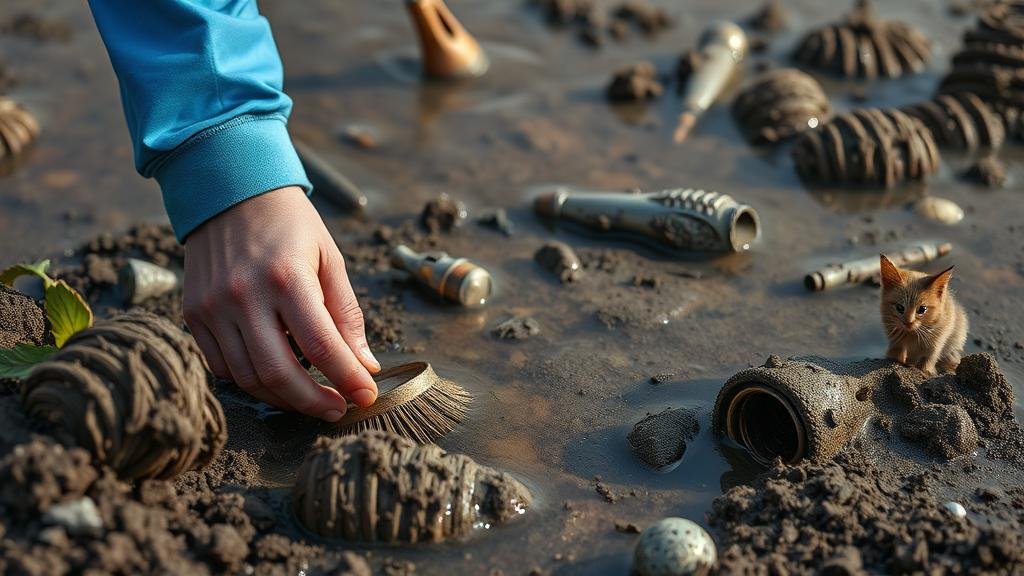Detecting in Waterlogged Basins and Ponds for Relics Preserved in Mud
Detecting in Waterlogged Basins and Ponds for Relics Preserved in Mud
Waterlogged basins and ponds serve as critical environments for the preservation of archeological relics. These anaerobic settings slow down the decomposition of organic materials, allowing valuable artifacts from past civilizations to remain intact for centuries. This article explores various methods and technologies employed in the detection and recovery of artifacts from these aquatic environments.
The Chemistry of Preservation
Artifacts submerged in waterlogged conditions are often preserved due to the absence of oxygen, which significantly hampers microbial activity. chemical composition of the mud, which can include high levels of silt and clay as well as organic matter, plays a crucial role in this preservation process. For example, peat bogs, known for their acidic properties, have been found to preserve wooden artifacts such as those from the Iron Age, including the famous “Lindow Man†found in England.
Methods of Detection
Detecting relics hidden in muddy waters requires a combination of traditional archaeological methods and modern technological advancements. Here are some commonly used techniques:
- Ground Penetrating Radar (GPR): GPR utilizes radar pulses to image the subsurface and detect anomalies. This non-destructive method is particularly effective in wet conditions where visibility is low.
- Sonar Mapping: Used primarily in underwater settings, sonar technology helps in mapping the contours of lake beds and identifying potential sites of interest.
- Magnetometry: This technique detects variations in the earths magnetic field caused by ferromagnetic materials, making it useful for locating metal artifacts in watery regions.
- Electromagnetic Induction: Similar to magnetometry, this method evaluates the conductivity of subsurface materials, helping to identify relevant archaeological deposits.
Case Studies
Several notable archaeological discoveries illustrate the effectiveness of these detection methods in waterlogged environments:
- Threave Castle: Located in Scotland, the use of GPR in the marshland surrounding the castle led to the uncovering of medieval artifacts that were previously undetectable.
- Bog Bodies in Denmark: Excavations in peat bogs have revealed numerous well-preserved bodies and objects, showcasing the natural preservation capabilities of these unique environments.
- The Thames Discovery Programme: In London, employing sonar mapping techniques has uncovered significant relics and shipwrecks that would have otherwise gone unnoticed.
Challenges in Detection
While these methods have been successful, detecting and recovering relics in waterlogged settings is not without challenges. Some of the primary difficulties include:
- Environmental Conditions: Changes in water level can obscure potential findings, making timely interventions critical.
- Legal and Ethical Concerns: Navigating property rights and regulations regarding water usage and archaeological digs can complicate recovery efforts.
- Technological Limitations: The effectiveness of detection technology may be hindered by the nature of the sediment, which can absorb or deflect signals.
Best Practices for Archaeologists
To optimize the likelihood of successful artifact recovery from waterlogged basins and ponds, archaeologists should consider the following best practices:
- Conduct Preliminary Surveys: Conduct surface surveys and utilize remote sensing technologies to map potential target areas before commencing actual digs.
- Collaborate with Local Authorities: Engage with local environmental agencies to understand legal frameworks and environmental guidelines.
- Preserve Artifacts In Situ When Possible: If artifacts can be preserved in their original context, this can yield valuable information regarding their spatial relationships and historical significance.
Conclusion
Detecting relics in waterlogged basins and ponds is a complex but rewarding endeavor that enriches our understanding of human history. The integration of traditional archaeological practices with modern technology creates a powerful framework for exploration. As techniques continue to evolve, archaeologists will be better equipped to uncover hidden treasures in the silty depths, ultimately contributing to the preservation of our cultural heritage.
As a takeaway, practitioners in the field should remain informed about advancements in detection technologies, maintain an ethical approach to excavations, and strive for collaboration with interdisciplinary teams to enhance the effectiveness of their recovery efforts.



